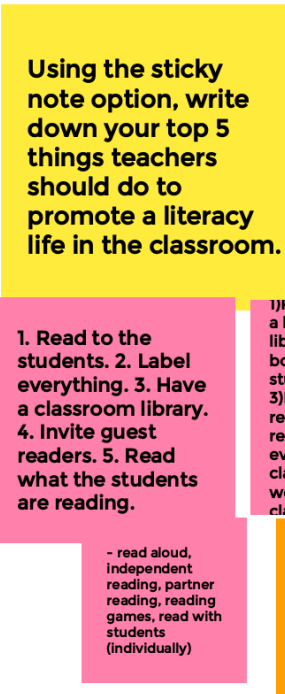Tags: Discussions, Interaction, Jamboard, Peer-Reviewed Entry, Reflection, Synchronous, Zoom

Description
When teaching remotely during synchronous online learning sessions, finding ways to engage the students as they enter the virtual meeting room is important to capture the students’ attention. Providing a hook also known as an anticipatory set is a one way to set the focus for the lesson to prompt student reflection and discussion. The hook is a critical part of the lesson because it is a way to activate thinking. Madeline Hunter (1982) refers to the beginning of the class time as “prime time” (p. 27). A successful hook has a prompt or trigger with clear expectations which can connect to writing, drawing, discussing, completing a problem or task (West & Deutsch, 2017).
The Center for Teaching at the University Iowa (n.d.) suggested seven ways to hook the learner. One way is to provide a quote for students to reflect on as they enter the virtual meeting room, allows every student to be involved. Providing a quote to reflect on or a question to answer challenges the students’ thinking. Fisher, Frey, and Hattie (2021) stated the time the teacher is in front of students in live virtual sessions should focus on the following opportunities: connection, discussion, and interaction. Giving students a question or quote to reflection on allows for these three opportunities occurs.
Using hooks to prompt student reflection and discussion can be implemented across disciplines. Consider these examples:
A professor of business management may pose a concern connected to customer service. Students may respond in the Zoom Chat or in a Google Document in shared screen mode by providing suggestion for improvement, with the understanding the lesson may provide additional ideas to consider.
A professor of criminal justice can pose statistics related to crime across the state. Students can make inferences as to why crime may be higher in one city compared to another city, which can be an effective way to lead into lesson and activate learning.
A hook used in a science course may be connected to developing questions to an experiment they will be conducting in the virtual learning lab. The students can determine if their predictions were correct based on the results.
A professor of history may choose to share historical photos. Students can share their ideas on the context of the photos and the historical time frame. Students can create a list of what they observe in the photos through a shared Google Document. After a discussion focused on the photos, the professor can move into the lesson for the day.
Link to example artifact(s)
Course: Communication Arts Integration
Instructor: Dr. Angela Danley
When meeting with students remotely in the Communication Arts Integration Course, Dr. Danley has students access Google Jamboard when they enter the Zoom session. Dr. Danley shares the Google Jamboard link in the chat room. Students access the link and read the quote. The quote connects to the learning session from the previous week or as a way to activate thinking for the current lesson or module. This can also be done using an interactive whiteboard, Padlet, or something similar.

Dr. Danley provides student 3-5 minutes to share their reflections on the Google Jamboard. When the time is up, Dr. Danley has the students take 2-3 minutes to look for patterns in the response. This prompts discussion to set the class up for the learning for the time they are on Zoom.

References
Fisher, D., Frey, N. & Hattie, J. (2021). The distance learning playbook, grades K-12. Thousand Oaks, CA: Corwin.
Hunter, M. (1982). Mastery teaching. El Segundo, CA: TIP Publications.
University of Iowa Center for Teaching (n.d.). Seven ways to hook your students. https://teach.its.uiowa.edu/sites/teach.its.uiowa.edu.
West, B.K., & Deutsch, A.C. (2017). Anticipatory sets: Setting the Stage for Learning. LOEX Quarterly, 44, 1-10.
Citation
Danley, A. (2022). “hook” the students to prompt reflection and discussion in synchronous sessions. In A. deNoyelles, A. Albrecht, S. Bauer, & S. Wyatt (Eds.), Teaching Online Pedagogical Repository. Orlando, FL: University of Central Florida Center for Distributed Learning. https://topr.online.ucf.edu/hook-the-students-to-prompt-reflection-and-discussion-in-synchronous-sessions/.Post Revisions:
- May 27, 2022 @ 11:32:58 [Current Revision]
- May 27, 2022 @ 11:32:58

